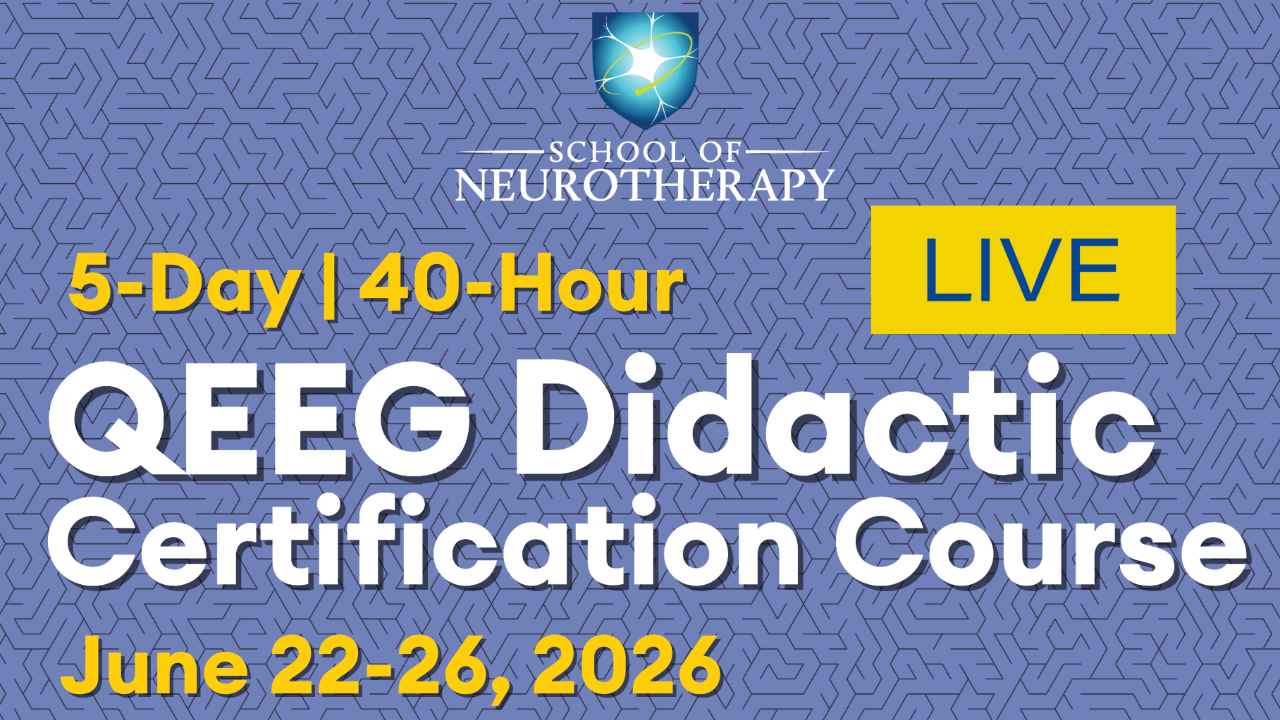
Ready to Learn How to Read The Brain?
Our options for training via online modules or live didactic training (or both) give you all you need for your QEEG certification.

QEEG Certification (QEEG-D & QEEG-T)
Here's What You'll Learn
This online self-paced course includes:
-
Videos That Demonstrate How To Read EEG And QEEGs
-
Articles On Important Clinical Findings, Required Readings For The QEEG Exam
-
Quizzes And Practice Exams To Test Your Knowledge
-
Lectures On How To Spot Clinically Relevant Information In Brain-Based Data
-
Analysis Of Tough Cases Like Mood Disorders, Epilepsy And ADHD

Course Chapters and Content
I. HISTORY - 1 HOUR
V. QEEG - 9 HOURS
II. NEUROSCIENCE - 8 HOURS
VI. PSYCHOPHARMACOLOGY - 2 HOURS
III. TECHNICAL - 4 HOURS
VII. RESEARCH - 2 HOURS
IV. EEG - 8 HOURS
VIII. ETHICS - 2 HOURS
IX. CLINICAL PRACTICE/FORENSIC - 4 HOURS
Steps To Earn A QEEG-D Or QEEG-T
- Register with the International Quantitative EEG Certification Board online here.
- Submit an application with documentation of the necessary educational prerequisite and pay a filing fee to the International Quantitative EEG Certification Board here.
- Get mentored! To receive the QEEG-D or QEEG-T designation, you must demonstrate competency through working with an established mentor, who has earned the status of QEEG-D. You will want to choose a mentor who is experienced in the field of neurotherapy and who has the skillsets and uses the types of software you would like to become proficient in. The mentor and mentee will spend a minimum of 10 contact hours together. The mentor must be a QEEG-D and will review five EEGs and QEEGs to check your competence in EEG acquisition and QEEG interpretation.
- Attend a 40-hour online didactic course—register here!
- Take the exam. The exam is three hours and consists of:
- Editing Raw EEG and Artifacts
- Drug Effects
- Database Analysis
- Clinical and Cognitive aspects of QEEG and EEG
- Topographic and Spectral EEG and Montages

Who Gets Quantitative EEG Diplomate Designations?
Anyone can take this course, the content can be applicable to anyone wanting to learn about EEG and Quantitative EEG. We welcome all who are interested to sample the course and register for an account on our site.
Clinically-licensed individuals (be it Registered Nurse, Clinical Psychologist, Marriage and Family Therapist) who gather clients’ EEGs and analyze that data are eligible for the QEEG-D. Non-licensed professionals can obtain the Quantitative EEG Technologist (QEEG-T) Certification. In the field of neurotherapy and applied psychophysiology, the QEEG-D and QEEG-T are seen as high distinctions denoting a clinician’s competence and experience in analysis.
To attain the QEEG-D credential, the applicant must prove competency to the International QEEG Certification Board IQCB) by submitting a CV, resume, and/or evidence of an acceptable degree. It is also mandatory that the individual is licensed/credentialed in a health care related field working in a clinical practice. Unlicensed individuals who are treating clinical issues (psychological and physiological disorders) are advised to work under a licensed professional.
Questions about QEEG-D Certification?
All questions related to the accreditation process are to be directed to the IQCB at [email protected].
All applicants seeking certification are to adhere to the International QEEG Certification Board’s Professional Standards and Ethical Principles here.
QEEG Live Didactic Training Coming Again in 2026!
>SPECIAL $300 Add-On Price on Live QEEG Course:
for those already enrolled in self-paced QEEG Certification Course!
>>LEARN MORE HERE! ...Where you can also learn more about sitting for the IQCB Exam on June 27th, 2026.
MENTORING Need More Guidance or Mentoring Hours?
Our QEEG Mentoring Course provides regular group mentoring sessions with Licensed QEEG Diplomate, Dr. Tiff Thompson.
Continue your QEEG education and meet your mentoring requirement toward your IQCB Certification.
>>This course provides the opportunity to qualify for 10 mentoring hours required for certification.




